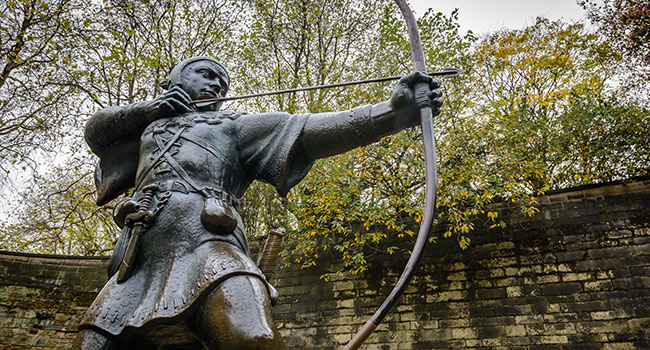 As historical figures go, Robin Hood is a source of perpetual fascination.
As historical figures go, Robin Hood is a source of perpetual fascination.
Mind you, I use the term “historical figure” very loosely because there’s no convincing evidence that he ever existed. Or at least not in anything resembling the legend we’re familiar with.
While the earliest written stories date back to ballads printed in the 15th century, we don’t know whether they refer to a real character, a composite or a completely fictional creation.
A Gest of Robyn Hode – circa 1450 – is perhaps the oldest documented rendering, but variations of the legend were apparently in oral circulation for a couple of centuries prior to that.
So what we have is as real as the tales of King Arthur’s Round Table. Which is to say, not very real at all.
Academics aren’t immune to the fascination. Lesley Coote, a medievalist at England’s University of Hull, is very much into the scene and her current offering is Storyworlds of Robin Hood: The Origins of a Medieval Outlaw.
Coote notes that Robin Hood types weren’t exclusively English. Similar tales were popular in other parts of medieval Europe.
She also reminds us that Robin is subject to regular cultural reinvention. The bawdy, brutal outlaw of the original ballads doesn’t fit with the noble figure of popular mid-20th-century presentations.
Coote recently talked about her introduction to the character. Like many of us, she came to it as a child. The critical elements for her were the written children’s stories by Roger Lancelyn Green and the 1950s television series.
Debuting in 1955, The Adventures of Robin Hood ran for four seasons. It was a British production that was also broadcast in North America and it was hugely popular.
Coote says she loved the stories but didn’t warm to the television portrayal of Robin. She couldn’t connect with him on a personal level.
He was “like some of my friends’ dads, managerial and posh-sounding. He was nice, but seemed so full of moral righteousness; he always did the right thing and kept telling other people about it.”
In contrast, the Robin Hood of the written stories was independent, irreverent and altogether more fun. “He was someone I would have liked to be with – if I’d seen the TV Robin coming down the street, I’d have dodged down an alley out of the way!”
I, too, became acquainted with Robin via written words and visual images. But my introduction was earlier than Coote’s and the screen was big rather than small.
The year was 1952 and I was seven-years-old when the classic 1938 Errol Flynn version of Robin came to the local cinema for one night. And it being Easter school holidays, I was given permission to go. Talk about anticipation!
Alas, I awoke with measles on the morning of the showing. There was to be no Robin for me that Easter.
The loss, however, was more or less recouped later in the year.
British post-war currency controls restricted Hollywood’s ability to repatriate revenues earned from exhibiting movies in Britain. But rather than leave the money stranded and dormant, some of the studios opted to deploy the funds by actually making films there. Costume dramas with lots of adventure were an obvious choice and one of these was The Story of Robin Hood and His Merrie Men.
Shot in 1951 using technicolour and authentic English locations – Sherwood Forest being one of them – the movie came to Dublin in the autumn of 1952 and I got to see it. Playing Robin, Richard Todd was sturdy, energetic and possessed all of the attributes a child’s imagination expected. He may not have been Errol Flynn, but he did the business for me.
There’ve been many further iterations and variations of Robin over the ensuing decades, some of which I’ve seen and others I haven’t. If I had to choose a favourite, it would be Robin and Marian (1976).
Be warned, though. It’s not a conventional rendering.
Middle-aged and feeling it, Robin (Sean Connery) has returned to England after a 20-year absence. Maid Marian (Audrey Hepburn) is an abbess, having been deserted by Robin when he went on his travels.
And not wanting to spoil the story, I’ll just say that it’s both bittersweet and entertaining.
If you’ve never seen it, it’s a good way to spend a couple of hours.
Troy Media columnist Pat Murphy casts a history buff’s eye at the goings-on in our world. Never cynical – well perhaps a little bit.
The views, opinions and positions expressed by columnists and contributors are the author’s alone. They do not inherently or expressly reflect the views, opinions and/or positions of our publication.

